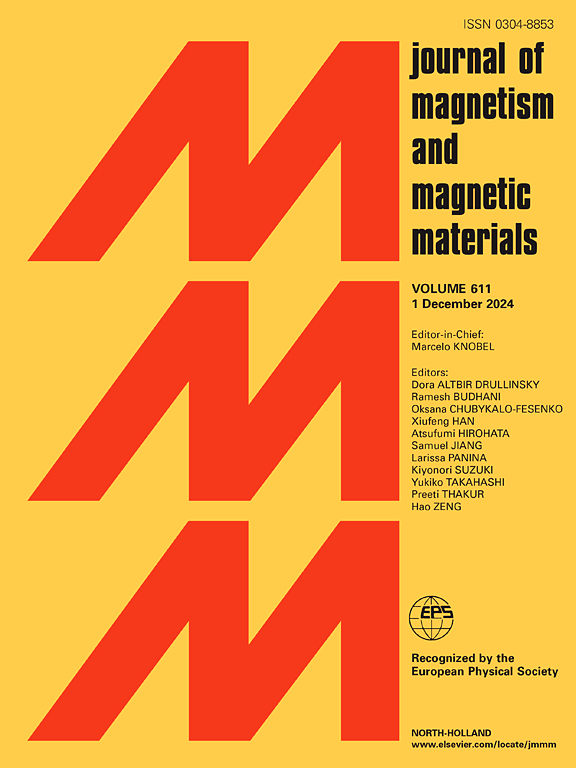Magnetoelectric effect behavior in layered perovskite-type of (1-x) BaTiO3–X MgFe2O4 composites
IF 2.5
3区 材料科学
Q3 MATERIALS SCIENCE, MULTIDISCIPLINARY
引用次数: 0
Abstract
The room temperature multiferroic behavior of (1-x)BaTiO3- xMgFe2O4 (x = 0.05, 0.15, 0.25, 0.35 and 0.45) 0–3 particulate and 2–2 laminated composites has been investigated. Powder X-Ray diffraction data confirms the formation of both perovskite tetragonal BTO and spinel cubic MFO phases coexist with the absence of impurity phases in the detectable limit. The SEM image of the composite samples provides an evidence for presence of two different phases (ferroelectric BTO and ferrite MFO) with different grain size and morphology. An enhancement of magnetization with the increase of ferrite molar fraction in the particulate composites reveals the unbalanced anti parallel spins between Fe3+ and Mg2+ ions attributes the magnetic property of the composites. Leakage, dielectric and ferroelectric properties of the particulate composites clearly shows leaky behavior of composites with the increase of MgFe2O4 concentration. Eventually, 0.65BaTiO3–0.35MgFe2O4 laminated composite with sandwich structure showed better ME coupling than 2–2 laminated bilayer and 0–3 particulate ceramic composites.
层状钙钛矿型(1-x) BaTiO3-X MgFe2O4复合材料的磁电效应行为
研究了(1-x)BaTiO3- xMgFe2O4 (x = 0.05, 0.15, 0.25, 0.35和0.45)0-3颗粒和2-2层合复合材料的室温多铁性。粉末x射线衍射数据证实了钙钛矿四方BTO和尖晶石立方MFO相共存,且在检测极限内没有杂质相。复合材料的SEM图像表明,复合材料中存在两种不同的相(铁电BTO和铁氧体MFO),它们具有不同的晶粒尺寸和形态。磁化强度随颗粒复合材料中铁氧体摩尔分数的增加而增强,表明Fe3+和Mg2+离子之间的不平衡反平行自旋决定了复合材料的磁性能。随着MgFe2O4浓度的增加,颗粒复合材料的漏电性能、介电性能和铁电性能清楚地显示出复合材料的漏电行为。最终,夹层结构的0.65BaTiO3-0.35MgFe2O4复合材料比2-2双层复合材料和0-3颗粒陶瓷复合材料具有更好的ME耦合性能。
本文章由计算机程序翻译,如有差异,请以英文原文为准。
求助全文
约1分钟内获得全文
求助全文
来源期刊

Journal of Magnetism and Magnetic Materials
物理-材料科学:综合
CiteScore
5.30
自引率
11.10%
发文量
1149
审稿时长
59 days
期刊介绍:
The Journal of Magnetism and Magnetic Materials provides an important forum for the disclosure and discussion of original contributions covering the whole spectrum of topics, from basic magnetism to the technology and applications of magnetic materials. The journal encourages greater interaction between the basic and applied sub-disciplines of magnetism with comprehensive review articles, in addition to full-length contributions. In addition, other categories of contributions are welcome, including Critical Focused issues, Current Perspectives and Outreach to the General Public.
Main Categories:
Full-length articles:
Technically original research documents that report results of value to the communities that comprise the journal audience. The link between chemical, structural and microstructural properties on the one hand and magnetic properties on the other hand are encouraged.
In addition to general topics covering all areas of magnetism and magnetic materials, the full-length articles also include three sub-sections, focusing on Nanomagnetism, Spintronics and Applications.
The sub-section on Nanomagnetism contains articles on magnetic nanoparticles, nanowires, thin films, 2D materials and other nanoscale magnetic materials and their applications.
The sub-section on Spintronics contains articles on magnetoresistance, magnetoimpedance, magneto-optical phenomena, Micro-Electro-Mechanical Systems (MEMS), and other topics related to spin current control and magneto-transport phenomena. The sub-section on Applications display papers that focus on applications of magnetic materials. The applications need to show a connection to magnetism.
Review articles:
Review articles organize, clarify, and summarize existing major works in the areas covered by the Journal and provide comprehensive citations to the full spectrum of relevant literature.
 求助内容:
求助内容: 应助结果提醒方式:
应助结果提醒方式:


